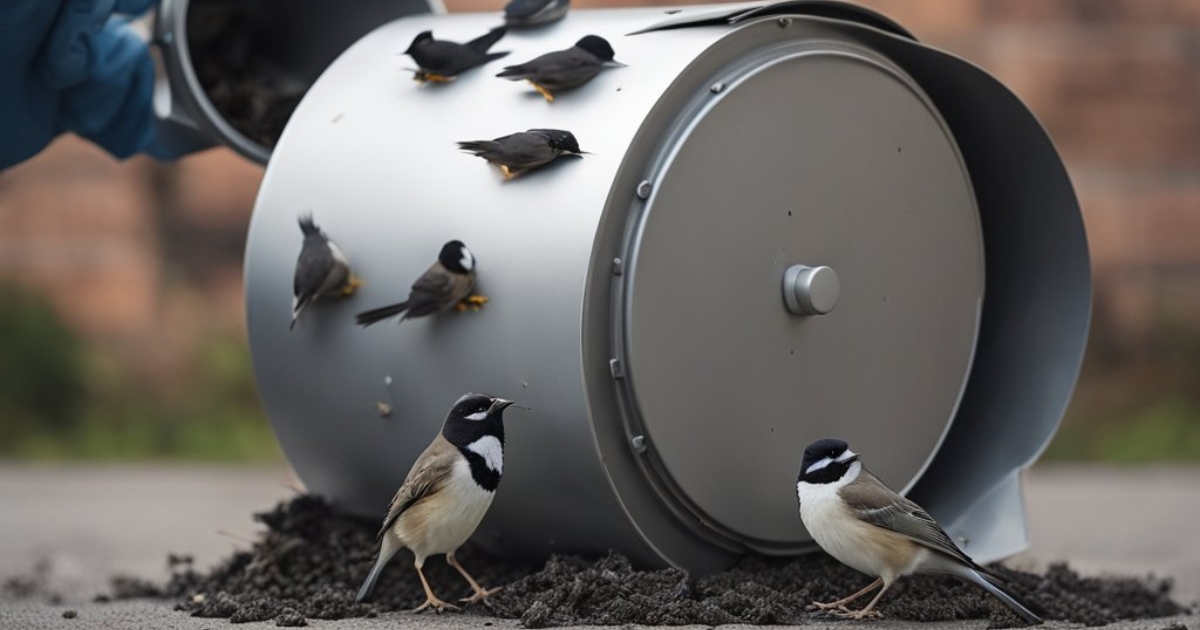Have you ever noticed little feathers or twigs scattered around your dryer vent? Or perhaps you’ve heard strange chirping sounds coming from the laundry room? If so, you might have a feathered squatter nesting in your dryer vent. While these winged visitors may seem harmless, their presence can pose serious risks, from fire hazards to clogged vents and even health concerns. Don’t worry, though – we’ve got you covered with this comprehensive guide on how to remove birds from your dryer vent safely and humanely.
Understanding the Issue
Why Birds Nest in Dryer Vents
Birds are attracted to dryer vents for several reasons. First and foremost, these vents provide warmth and protection, making them an ideal nesting spot, especially during the colder months. Additionally, dryer vents offer an accessible entry point, allowing birds to easily come and go. And let’s not forget the lack of predators – a dryer vent can be a cozy, secure haven for feathered families.
Potential Consequences
While having a bird’s nest in your dryer vent might seem like a cute and harmless situation, it can actually lead to some serious consequences. One of the most significant risks is fire hazards. Nesting materials, such as twigs, leaves, and feathers, can accumulate and block the vent, restricting airflow and causing the dryer to overheat, potentially leading to a fire.
Furthermore, clogged vents can cause moisture buildup, creating an ideal environment for mold and mildew growth, which can pose health risks to you and your family. Not to mention the potential damage to your dryer itself, as a blocked vent can put unnecessary strain on the appliance, leading to costly repairs or replacements.
Preventive Measures
Inspecting and Maintaining Dryer Vents
The old adage “an ounce of prevention is worth a pound of cure” rings true when it comes to keeping birds out of your dryer vent. Regular cleaning and inspection of your dryer vent system are crucial steps in preventing bird nesting. Aim to clean the vent at least once a year, removing any accumulated lint, debris, or potential nesting materials.
Additionally, consider installing vent covers or screens to physically block access to the vent opening. These covers should be sturdy and securely fastened to prevent birds from dislodging them. Don’t forget to seal any potential entry points around the vent with caulk or weatherstripping to eliminate gaps where birds might squeeze through.
Deterrents and Repellents
If you’re dealing with persistent avian visitors, you might want to consider using deterrents and repellents. Visual deterrents, such as reflective tape, hanging objects, or predator decoys, can discourage birds from nesting in your dryer vent area. Auditory deterrents, like ultrasonic devices or recordings of predator calls, can also be effective in scaring away unwanted feathered guests.
For more stubborn cases, you might need to resort to chemical repellents. However, it’s essential to use these products cautiously and follow the manufacturer’s instructions to the letter, as some chemicals can be harmful to both birds and humans if used improperly.
Humane Removal Methods
Observing and Monitoring
Before attempting to remove a bird’s nest from your dryer vent, it’s crucial to observe and monitor the situation carefully. Identify when the birds are most active and when they’re away from the nest. This information will help you determine the best time to safely and humanely remove the nest without disturbing or harming any birds or nestlings.
Gentle Removal Techniques
Once you’ve identified the optimal time for removal, there are several gentle techniques you can employ. One option is to use a shop vacuum with a long hose attachment to carefully remove the nesting materials from the vent. This method can be effective for removing loose materials, but it’s essential to be cautious and avoid disturbing any eggs or nestlings.
Another approach is to encourage the birds to relocate by making their current nesting spot less desirable. You can do this by gently removing a portion of the nest each day, prompting the birds to seek a new, more suitable location.
In some cases, it might be necessary to seek professional assistance, especially if the nest is difficult to access or if you suspect the presence of nestlings or eggs. Professional wildlife control experts have the knowledge and experience to safely and humanely remove bird nests while adhering to local regulations and best practices.
Handling Nestlings and Eggs
If you encounter nestlings or eggs while attempting to remove a bird’s nest from your dryer vent, it’s crucial to proceed with utmost care and sensitivity. Disturbing or removing nestlings or eggs without proper precautions can be harmful and potentially illegal in some areas.
If you find yourself in this situation, it’s best to leave the nest alone and seek guidance from local wildlife rehabilitation centers or animal control authorities. They can provide you with the appropriate steps to ensure the safety and well-being of the birds while addressing the issue in a responsible and humane manner.
Post-Removal Measures
Cleaning and Sanitizing
Once the bird’s nest has been successfully removed from your dryer vent, it’s essential to thoroughly clean and sanitize the area. Start by removing any remaining nesting materials, feathers, or debris from the vent and surrounding area.
Next, use a disinfectant solution or bleach mixture to sanitize the vent and any affected surfaces. This step is crucial to eliminate potential health risks from bacteria, parasites, or other contaminants that may have been present in the nest.
Sealing and Securing
After cleaning and sanitizing, it’s time to seal and secure the dryer vent to prevent future bird nesting. Cover any entry points with durable mesh or screens, ensuring they are securely fastened and leave no gaps for birds to squeeze through.
Consider installing vent guards or covers specifically designed to block access to dryer vents while allowing proper airflow. These products can provide an added layer of protection and make it more difficult for birds to gain entry.
Monitoring and Maintenance
Even after you’ve taken preventive measures, it’s essential to continue monitoring your dryer vent regularly. Keep an eye out for any signs of new nesting activity, such as feathers, twigs, or chirping sounds.
Regular maintenance, including cleaning and inspecting the vent system, is also crucial to ensure that your efforts to keep birds out remain effective over time.
Preventing Future Nesting
Landscaping Considerations
Aside from sealing and securing your dryer vent, there are additional steps you can take to discourage birds from nesting in or around the area. One effective strategy is to remove potential nesting sites in your landscaping, such as dense shrubs or ivy, which can provide ideal nesting spots for birds.
Alternatively, consider planting deterrent plants like herbs or plants with strong scents that birds tend to avoid. Lavender, mint, and citronella are just a few examples of plants that can help deter birds from nesting in your yard.
Structural Modifications
If you’re dealing with a persistent bird nesting problem, you might want to consider making structural modifications to your home or property. This could involve covering vents, openings, and potential entry points with durable mesh or screens.
Additionally, installing slanted surfaces or overhangs can make it more difficult for birds to build nests in certain areas, as they prefer flat, stable surfaces for their nests.
Professional Assistance
While many of the methods described in this guide can be effective for removing birds from your dryer vent, there may be situations where seeking professional assistance is necessary. If you’re uncomfortable with any of the removal or prevention techniques, or if you suspect the presence of protected or endangered bird species, it’s best to consult with a qualified wildlife control expert.
These professionals have the knowledge, experience, and proper equipment to safely and humanely remove bird nests while adhering to local regulations and best practices. They can also provide valuable advice on prevention strategies and structural modifications to deter future nesting.
People Also Read:
Conclusion
Dealing with birds nesting in your dryer vent may seem like a minor inconvenience at first, but ignoring the issue can lead to serious consequences, from fire hazards to health risks. By following the steps outlined in this comprehensive guide, you can safely and humanely remove birds from your dryer vent while taking preventive measures to discourage future nesting.
Remember, coexisting with nature is important, but it’s equally crucial to address potential hazards and maintain a safe living environment for you and your family. With patience, vigilance, and a commitment to humane practices, you can strike the right balance and enjoy a bird-free dryer vent while respecting the natural world around you.
FAQs
Is it legal to remove a bird’s nest from my dryer vent?
In most cases, it is legal to remove a bird’s nest from your dryer vent, as long as you follow proper procedures and take precautions to avoid harming the birds or violating any local wildlife protection laws. However, it’s always best to check with your local authorities or wildlife rehabilitation centers for specific regulations in your area.
What should I do if there are eggs or nestlings in the nest?
If you encounter eggs or nestlings while attempting to remove a bird’s nest, it’s best to leave the nest undisturbed and seek guidance from local wildlife rehabilitation centers or animal control authorities. Disturbing or removing eggs or nestlings without proper precautions can be harmful and potentially illegal.
How often should I inspect my dryer vent for bird nests?
It’s recommended to inspect your dryer vent at least once a year, preferably in early spring before the nesting season begins. Regular inspections will help you identify any potential nesting activity and take preventive measures before a full-fledged nest is established.
Can I use chemical repellents to deter birds from my dryer vent?
While chemical repellents can be effective in deterring birds, it’s crucial to use them with caution and follow the manufacturer’s instructions carefully. Some chemicals can be harmful to both birds and humans if used improperly. It’s generally recommended to explore humane deterrents and exclusion methods first before resorting to chemical repellents.
How can I prevent birds from nesting in my dryer vent in the future?
To prevent future bird nesting in your dryer vent, consider implementing the following strategies:
- Install vent covers or screens to physically block access
- Seal any potential entry points around the vent with caulk or weatherstripping
- Remove potential nesting sites in your landscaping, such as dense shrubs or ivy
- Plant deterrent plants with strong scents that birds tend to avoid
- Make structural modifications, such as installing slanted surfaces or overhangs

